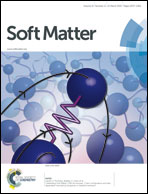Stripe to slab confinement for the linearization of macromolecules in nanochannels
Abstract
We investigated the recently suggested advantageous analysis of chain linearization experiments with macromolecules confined in a stripe-like channel (Huang and Battacharya, EPL, 2014, 106, 18004) using Monte Carlo simulations. The enhanced chain extension in a stripe, which is due to the significant excluded volume interactions between the monomers in two dimensions, weakens considerably on transition to an experimentally feasible slit-like channel. Based on the chain extension–confinement strength dependence and the structure factor behavior for a chain in a stripe, we infer the excluded volume regime (de Gennes regime) typical for two-dimensional systems. On widening of the stripe in a direction perpendicular to the stripe plane, i.e. on the transition to the slab geometry, the advantageous chain extension decreases and a Gaussian regime is observed for not very long semiflexible chains. The evidence for pseudo-ideality in confined chains is based on four indicators: the extension curves, variation of the extension with the persistence length P, estimated limits for the regimes in the investigated systems, and the structure factor behavior. The slab behavior can be observed when the two-dimensional stripe (originally of a one-monomer thickness) reaches a reduced thickness D larger than approximately D/P ≈ 0.2 in the third dimension. This maximum height of a slab at which the advantage of a stripe is retained is very low and has implications for DNA linearization experiments.


 Please wait while we load your content...
Please wait while we load your content...